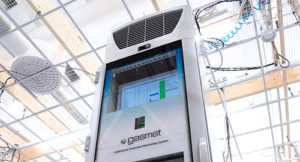CEMS II e increases flexibility in continuous emissions monitoring
Gasmet’s vision is to live on a planet with less emissions. To fulfill this mission, we manufacture reliable and complete continuous emissions monitoring systems. We specialize in two different kinds of monitoring systems: 1) Continuous Mercury Monitoring system and 2) Continuous Emissions Monitoring system for other gas compounds. In this article, we will introduce the latter: CEMS II e for Continuous Emissions Monitoring needs. It offers TÜV and MCERTS certified solutions (QAL1) for a wide range of demanding emission monitoring applications.
Gasmet CEMS II e Is designed for flexible and versatile emissions monitoring
Gasmet CEMS II e is a continuous emissions monitoring system that is designed for flexible and versatile emissions monitoring purposes. Thanks to the fully automatic system and FTIR (Fourier Transform Infrared) spectroscopy, CEMS II e enables simultaneous measurement of up to 50 gases with varying gas measurement ranges. CEMS II e is suitable for a wide range of industrial processes – from waste incineration to cement plants and beyond. As mentioned earlier, the system holds both TÜV and MCERTS certifications (QAL1).
The system consists of the following modules:  Gasmet CEMS II e modules.
Gasmet CEMS II e modules.
Main benefits of CEMS II e
CEMS II e is a versatile and user-friendly solution that adjusts to changes and future advances of emissions monitoring best practices with little effort. Here are our thoughts on what makes it the most efficient continuous emissions monitoring system on the market:
- Modular features and design promote flexibility
CEMS II e is not only flexible in terms of its wide spectrum of purposes of use, but also in terms of its modular design. The modularity and various design possibilities of CEMS II e allow the device to be modified according to its user’s needs: different modules can be assembled and stacked in the monitoring cabinet depending on the user’s needs.For example, FID can be added easily in the system in order to measure Total Organic Carbons (TOCs), and Gasmet provides a GFID for certified TOC measurements. However, TOCs can also be measured with the FTIR analyzer.In addition, the modular nature of the system offers more flexibility for maintenance: instead of having the whole system maintained, a singular module can be sent off to maintenance of local service separately. There are several options for CEMS II e maintenance, making the system easy and flexible for the user to operate. What is more, the approved maintenance interval of this device is the longest available on the market – up to 6 months, which can be obtained only by 12 months’ field testing performed according to EN15267 standard.
- Future-proof software ensures long life-cycle for CEMS II e
Gasmet’s Calcmet software for CEMS II e is designed to endure any changes to emissions monitoring best practices that may occur in the course of time. What this means in practice is that adjusting measurement ranges and adding new components to the analysis can be done with little effort, without any changes to the hardware.For example, if analysis shows any unidentified components in the sample gas, by doing a straightforward library search the software is able to identify the unknown component effortlessly and efficiently. It can then be added to the analysis and the measured raw data re-analyzed. Thanks to the easy use of the system, anyone operating the monitoring system can run any necessary updates. All data is stored, which allows all re-analyses of measured data also in retrospect.CEMS II e system and its Calcmet software are designed to support each other seamlessly. Seamless compatibility of the software and the device allow the effective design of future updates. They are also designed to be as customer-oriented and user-friendly as possible.
- Proven measurement and certifications
Gasmet has held its first TÜV certificate long before the publication of the EU Standard EN 15267, and throughout history, all Gasmet Continuous Emissions Monitoring Systems have always been certified. This is also at the core of all Gasmet operations: we take pride in making sure all our current devices and future solutions are certified.MCERTS and TÜV certifications that CEMS II e holds, have a high number of certified gases, as seen below. In addition to these certified compounds, Gasmet offers the standard emissions monitoring package consisting of the following 16 gases: H2O, CO2, CO, N2O, NO, NO2, SO2, HCl, HF, NH3, CH4, C2H6, C3H8, C2H4 and CH2O.CEMS II e is capable of measuring all the key and generally measured gas pollutants.CEMS II e can measure the following certified compounds simultaneously:

The calculated uncertainties for all components are within both the IED requirement and the stricter EN15267-3 standard.
Availability of CEMS II e is 98.4%, which substantially surpasses the test standard limit of 95%.
- CEMS II e Is Gasmet’s Own Product and Technology
With more than 30 years of experience, Gasmet is proud to be at the forefront of development in the field of gas analyzers and Continuous Emissions Monitoring. Our local and global presence enables us to offer tailored and best possible service for our customers around the world. All our products have always been handmade in Finland from the very beginning. A strong value chain management allows us to create high value for our customers. The finest technology developed by us ensures the highest possible quality of the products.With our service and support network covering more than 80 countries, we ensure local, high-quality technical support for our customers and secure continuous availability of spare parts to our systems during their entire lifetime.
| Learn more about our CEMS II e
CEMS II e offers modular and TÜV and MCERTS certified (QAL1) solution for environmental compliance in industrial processes, such as powerplants, waste incineration, cement plants and beyond. The system adjusts to changes in regulations and future advances of emissions monitoring best practices with ease. |
 |
